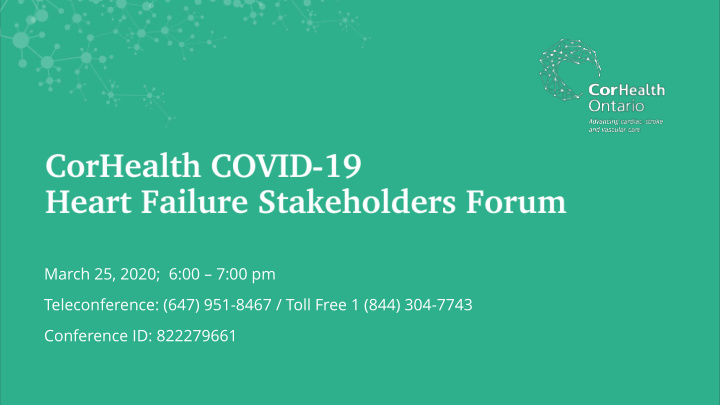



March 25, 2020; 6:00 – 7:00 pm Teleconference: (647) 951-8467 / Toll Free 1 (844) 304-7743 Conference ID: 822279661
Description Presenter Time Sheila Jarvis 18:00 1. Welcome System Planning Updates • Meeting Objectives • Dr Heather Ross 18:05 2. MOH Memo and CCS Recommendations Overview Dr Heather Ross 18:15 3. Ambulatory Heart Failure Care and COVID-19 in Ontario Current approaches and strategies • Virtual care: UHN example • All 18:50 4. Other Considerations and Next Steps 2
SHEILA JARVIS
• COVID-19 landscape is rapidly evolving • Keeping front line health care providers healthy is vital as we manage the COVID-19 pandemic. • Minimizing the impact of COVID-19 on the mortality and morbidity of patients with heart failure is a priority • Province and hospital specific infection prevention and control policies and protocols exist • Promoting clinical activities aimed a preserving hospital resources (i.e. health care human resources, PPE, ICU’s, ER’s) is also a priority. 4
1. To understand whether programs have already begun to develop guidance documents and/or strategies for the management of ambulatory heart failure clinic visits during the COVID-19 outbreak. 2. To identify the need for provincial guidance documents to monitor and manage ambulatory heart failure patients during the COVID-19 outbreak. 5
DR HEATHER ROSS
• “ Each hospital, health system, and physician should review all scheduled elective procedures with a plan to postpone or cancel electively scheduled operations, endoscopies, or other invasive procedures until such time that hospitals are able to accommodate these additional procedures.” • “ Non-emergent activity should be reduced in a step-wise manner in order to preserve, to the greatest degree possible, access for time-sensitive care. This would include, but is not limited to: • Time-related disease like certain cancers, particularly if the outcome is treatment-related; • Cardiac procedures for which there is risk of significant morbidity or mortality if delayed; and, • Non- emergent activity that will or may convert to emergent.” • Immediately adopt a stewardship approach to minimize use of essential items needed to care for patients , including but not limited to: ICU beds, PPE, cleaning supplies, and ventilators. 7
• MOH has issued memos related to OHIP payments to support virtual visits, virtual home care delivery • CCS has released a number of recommendations, including ambulatory care and specialty clinics 8
Current Approaches & Strategies DR HEATHER ROSS
• How are people responding to the direction from the MOH and CCS recommendations for ambulatory management of HF patients? Scenarios Approaches in the setting of COVID-19 Face-to-face clinic visits Are you continuing with any in-person clinic visits? Who and how is triaging/decision making occurring? • Who will remain scheduled? • What processes are in place to minimize COVID risk to patients • and staff? 10
Scenarios Approaches in the setting of COVID-19 Patient What are the minimum, critical requirements for patient monitoring/surveillance? monitoring/ For example: surveillance What resources are needed - clinical, administrative and technical? • What key pieces of information should be routinely collected from patients? • How often should this information be formally collected? • Patient What are the minimum, critical requirements for virtual care patient management? management/ For example: intervention Are there additional resources needed that are not identified above? • Is there additional information that may be required to guide patient management • decisions not identified above? How are you accessing and arranging for these resources or information to guide • treatment? 11
Low risk Medium risk Medium risk High risk NYHA FC 1 2-3 2-3 3-4 GDMT yes optimized Still titrating Symptoms none No orthopnea, PND or No orthopnea, PND or Recent or new syncope, ICD shock, syncope syncope Other Stable/low BNP Stable/low BNP Home iv inotropes Requiring iv diuretics High and/or increasing BNP Worsening cardiorenal syndrome Multiple admissions in last 6 mo Recent (<30d) hospital discharge for ADHF Worsening volume overload Work up for advanced therapies (HTx, VAD) Follow up Defer follow As per usual More frequent for titration Early follow-up up 6 mo Medly enabled Mode of standard Medly/telephone/OTN Medly/telephone/OTN On board Medly/OTN/*in person Follow up *Note: in-person visits should be limited to patients for whom critical volume assessment is required, or for those with high likelihood of requiring admission and/or IV therapies Caveat: chronic HF patients with worsening cough, breathlessness should be considered for COVID19 testing 12
• Do we need to consolidate this information into general guidance for all HF clinics? 13
EXAMPLE: MEDLY
15
16
17
18
19
20
21
22
23
24
25
26
27
• Are there other issues we should be considering/discussing? • How should we compile and address this list? • Are you willing to share your resources with other centres? • Are you willing to have your document integrated into a provincial summary document? 29
• CorHealth activities • Future meetings 30
32
33
34
Recommend
More recommend